ROC to bank another $1M, secures new strategic investor, and board member
Disclosure: S3 Consortium Pty Ltd (the Company) and Associated Entities own 6,575,000 ROC shares and the Company’s staff own 125,000 ROC shares at the time of publishing this article. Some shares are subject to approval in an upcoming EGM. The Company has been engaged by ROC to share our commentary on the progress of our Investment in ROC over time.
A tech focused investment fund is making a strategic $1M investment into our latest small cap tech Investment Rocketboots (ASX:ROC).
ROC has developed and is now selling AI vision software that combats “shrinkage” or lost retail inventory and helps optimise workforce efficiency.
Bombora Investment Management is investing $1M into ROC on the same terms as the 8c capital raise earlier in the week.
Bombora’s new $1M investment means ROC’s $3M capital raise has now been upsized to $4M.
Bombora will be a substantial shareholder in ROC at circa 7.5%.
And Bombora’s co-founder David Willington is joining ROC’s board.
Bombora has had a successful outcome with ROC Chairman Roy McKelvie before, and perhaps that is what attracted them to the ROC opportunity.
Roy is also the chairman of a private company called Pathify that recently secured a $180M valuation following a US$25M capital raise.
Bombora first invested in Pathify at a $26M valuation, and were able to take some money off the table in the recent larger funding round (a rare event for a private investment).
ROC’s Chairman, Roy comes from a private equity background and his experience was one of the big reasons for our Investment.
Roy also invested in the last two ROC capital raises - $200k at 8.5c and $90k in this week's raise at 8c - we like it when boards are aligned to shareholders like this.
Post ROC’s $4M capital raise, the company will be capped at ~$13M (at 8c).
ROC’s existing paid clients like Bunnings and Suncorp use ROC tech to more efficiently deploy employees at peak times in stores.
We Invested in ROC after it had spent years developing and marketing its product, and we think it is now at the point where it can materially start to scale up its revenue.
Looks like the tech investing specialists Bombora agree.
ROC has an “advanced stage sales pipeline” worth ~$35M in Annual Recurring Revenue (ARR)...
This could translate to a market valuation of multiples of this number.
However this is an early stage company - that potential future revenue number is based on our very crude back of the napkin calculations. A sales pipeline doesn't always fully convert, and things can take longer than first thought.
(More on the sales pipeline and why we Invested later in today’s note).
ROC is the latest addition to our Portfolio. You can check out our full initiation note from Monday here.
Today we will cover:
- ROC’s new strategic investor - Bombora Investment Management
- The 8 key reasons why we are Invested in ROC
- Our ROC Big Bet (and how we think ROC can achieve it)
- What we want to see next from ROC
More on ROC’s new strategic investor, Bombora...
Bombora Investment Management is an early stage tech focused investment manager - BUT they aren’t just exchanging capital for investment positions.
A big part of their strategy ”is to partner with management teams of rapidly growing businesses and inject a combination of capital and expertise”.
Exactly what we think ROC can benefit from now as it goes about scaling up its business...
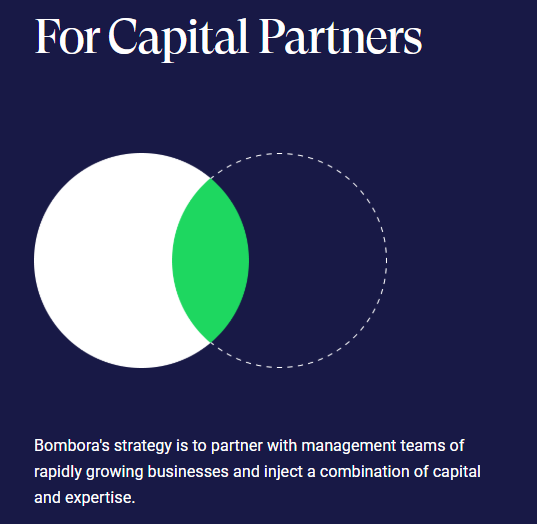
(Source: Bombora website)
As we mentioned above, Bombora has had some success with ROC’s chairman Roy McKelvie in other ventures, and perhaps that’s what led Bombora to invest in ROC today.
Bombora were early backers of Pathify, which, as chairman, Roy oversaw the growth of a small ed tech start-up to recently closing a US$25M funding round that valued the company at $180M.

(Source)
Bombora seems to have a pretty good track record backing early stage tech names...
Back in 2013 they took a strategic investment in another ASX listed cloud services tech company called rhipe (RHP) at a ~$13M valuation (they also took a board seat).
Five years later rhipe was trading with a market cap of $300M and was paying out dividends to shareholders.
Since then Bombora says it has “replicated this model seven times”...
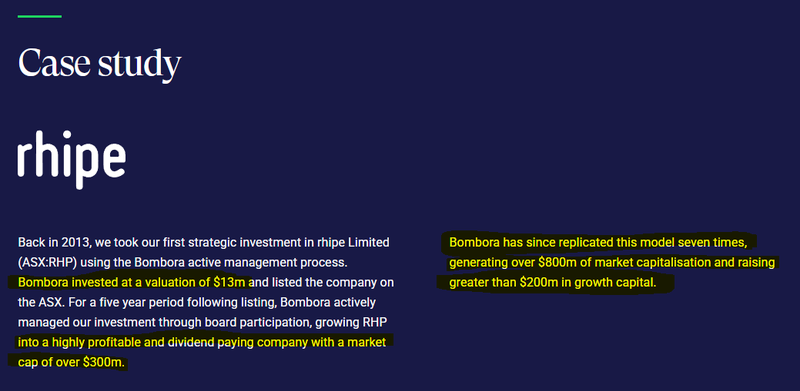
(Source)
It sounds to us like Bombora has a well thought out playbook that they can execute on companies they like.
Strategic investment at a low valuation, a board seat (hands on approach) and a fairly medium/long term approach to let an Investment play out.
The commentary from Bombora’s Portfolio Manager and co-founder David Willington in today’s ASX announcement was pretty telling:
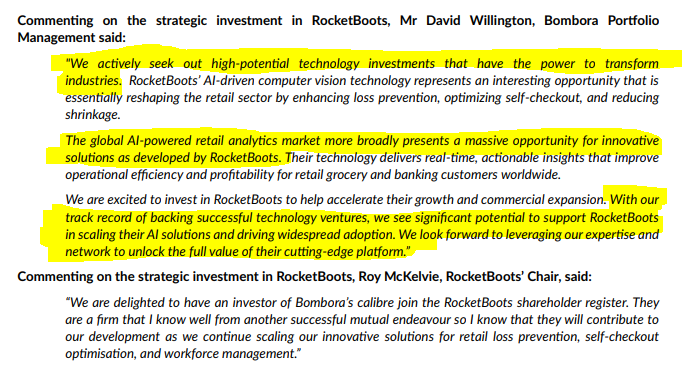
(source)
Bombora doesn't seem like they are coming into ROC for a passive cash investment or a “quick flip” for a 50% gain.
They understand the tech, understand the market environment and probably have a vision on execution.
They: have taken a seat on the board to be very involved in ROC’s growth.
Now, they get to come into ROC at a potential inflection point for the company with a meaningful stake and upside to its potential success.
We think Bombora with their tech focused investment background will understand the competitive landscape very well.
They have a consumer/retail specialist on their team so they will know what’s good, what’s bad and what’s needed from all the other investments they make (and reject).
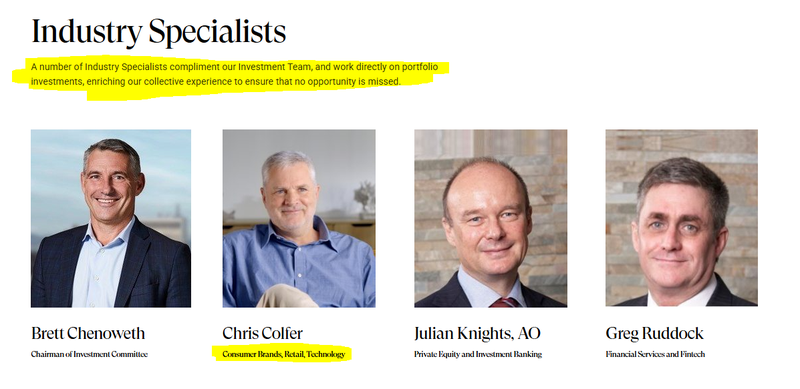
(Source)
Overall it’s good to see them pull the trigger on a fairly big chunk of ROC.
Bombora will hold ~7.5% of ROC after the capital raise is completed.
It’s also good to see them come in at the same price as us and the other capital raise participants at 8c per share.
Hopefully with them on board as a strategic investor, ROC can execute on that hockey stick growth projection we mentioned above, and in detail in our ROC initiation note on Monday.
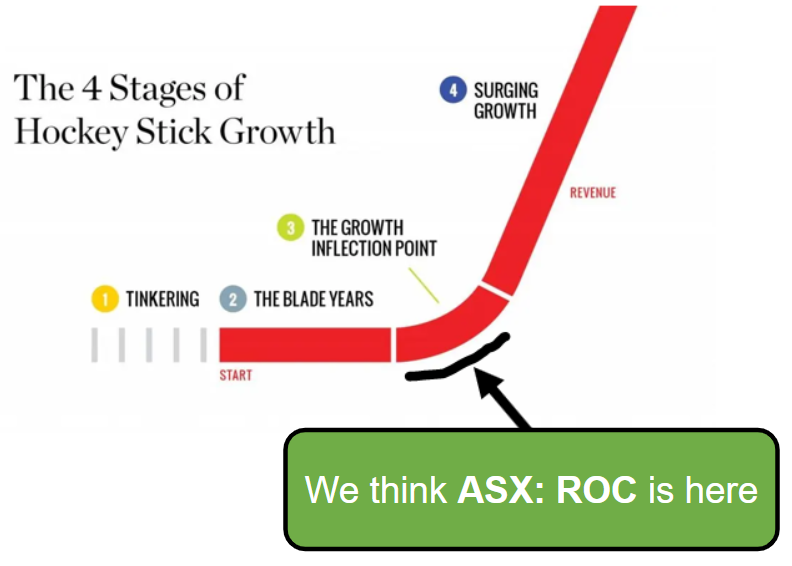
Of course that hockey stick growth is never a guarantee, and plenty of high potential tech companies never quite make it to the ‘surging growth’ phase.
We will have to wait and see for ROC.
You can check out our full initiation note from Monday here, in that note we run through:
- What ROC does and why we like it’s tech
- The 8 key reasons why we are Investing in ROC
- What ROC sells and who it sells it to...
- What our Big Bet is for ROC and a full breakdown of how we think it can achieve it
- Our detailed ROC Investment Memo
8 key reasons why we are Invested in ROC
Below is a repeat of the 8 key reasons we mentioned in Monday’s note - this was prior to Bombora coming in for a $1M investment into ROC.
- ROC already has long term, paying enterprise customers including Bunnings and Suncorp.
Both Bunning (large DIY goods retailer owned by Wesfarmers) and Suncorp (community bank owned by ANZ) are paying customers of ROC.
They have been customers since before ROC’s December 2021 IPO and continue to renew and expand their licence contracts 7+ years later.
This is strong evidence that ROC can sell its product to enterprise customers, and that those customers find long term value out of the service. - Over ~$35M in potential annual recurring sales from “advanced stage deal pipeline”
According to ROC’s most recent quarterly report, ROC had 10 customers in its “Advanced Pipeline”.
These customers represent over 10,000 sites in total.
At $3,500 per site per year, by our rough, basic calcs this represents over $35M in potential annual recurring revenue if ROC is able to convert into sales.
(using a basic $3,500 per site per year times number of sites calc, ignoring bulk discounts and setup fees)
Even if just 10% of that “advanced stage” pipeline is converted, it would be 3.5x ROC’s current revenues. - One large deal could multiply ROC’s current revenue
If ROC is able to sell to a large multinational contract it could have its product in thousands of stores through just one deal.
At a price point of $3,500 per store, one deal could be in the millions of dollars in recurring free cash flow.
These deals take a very long time to secure (as do most enterprise software deals).
ROC has shown that its enterprise customers tend to be incredibly “sticky” (stay on for a long time) - Partnership with Europe’s largest Point of Sale company: Gebit Solutions
Gebit Solutions sells self checkouts to supermarkets and retailers.
Gebit is the point of sale system for some of the largest supermarket retailers in Europe and Gebit will now support an “out of the box integration” with ROC’s software.
High-synergy partners like Gebit help improve ROC’s reputation to enter the conversation with big retailers, despite ROC being a smaller player in the space. - Original founding team still in place, with a new experienced tech chairman at the helm
The original team that developed ROC’s technology in the early 2010s are still running the company (including the CEO and CTO).
This is a positive sign for tech startups when a long term founding team has been working on the product for 10+ years.
Now however, ROC has a new chairman with experience in both private equity and tech enterprise sales.
ROC’s new chairman Roy McKelvie is also the chairman of an education technology company called Pathify that he helped to scale and raise US$25M at a A$180M valuation.
Roy invested $200,000 personally into ROC last year at 8.5 cents and a further $90,000 in the current placement. - Genuine AI and deep knowledge of how to apply AI to a specific problem
ROC’s AI and machine learning technology has been developed since 2010.
(well before AI became big Investment theme)
Companies developing genuine AI with over a decade of development efforts AND internal knowledge on how to apply AI to solve a specific and real world problem are rare on the ASX...
And in our view are the best positioned to leverage and apply the rapid recent advances in AI technology and tools to their specific sector of expertise. - Vision capture technology valued in the US$250M-$500M range
In late 2022 a company called Trigo raised US$100M off the back of its grocery vision software.
In 2023 one of the largest companies in this space Everseen raised US$70M to advance a very similar technology.
Those large raises are evidence of the size of the opportunity in this space that investors are seeing.
If ROC is able to deliver more sales and capture market share, it could grow to the size of these larger competitors in the space. - ROC has a good capital structure with strong ownership represented in board and management
Following today’s capital raise news and its completion, ROC will have 154 million shares on issue.
The major shareholders are the original vendors of the technology and have proven to be sticky since the IPO.
The board and senior management represent ~44% of the shares on issue prior to this recent capital raise, which means they are very aligned to shareholders interests.
UPDATE (4th April 2025): After today’s news ROC will have ~166M shares on issue. Bombora’s shares are likely to be fairly sticky too given they are taking a board seat in the company... We think ROC’s capital structure remains strong.
Ultimately, we are hoping that a combination of the above reasons helps it achieve our Big Bet which is as follows:
What is our Big Bet for ROC?
“ROC re-rates to a $200M market cap by securing multiple large recurring contracts with retail clients and scaling up its business”
NOTE: our “Big Bet” is what we HOPE the ultimate success scenario looks like for this particular Investment over the long term (3+ years). There is a lot of work to be done, many risks involved - just some of which we list in our ROC Investment Memo. Success will require a significant amount of luck. There is no guarantee that our Big Bet will ever come true.
Breaking down the “bet” for ROC
This is how we are breaking down the “bet” on ROC. There are two questions to be evaluated:
- Will ROC be able to close multiple big enterprise sales in the future?
- If they can, is the prize big enough to justify the risk of ROC not closing the sales?
Why YES... ROC’s team can close multiple big sales:
- The new chairman knows enterprise tech sales. Roy has had experience in enterprise tech sales and is more hands-on than the previous chairman.
- Customers already like the product. ROC has multiple paying enterprise customers that have renewed the product (including Bunnings). This is validation that the ROI of buying the product is enough to justify the cost.
- Partnerships. ROC has a key partnership with a top technology vendor that is in tens of thousands of supermarkets across the world: Gebit Solutions.
- Time. There has been 4+ years of building relationships with key customers and 10+ years of developing the product.
- Value proposition becoming more relevant to the customers:
- Self checkout is reducing headcounts for supermarkets but increasing theft, affecting a key part of the bottom line.
- Brick and mortar bank branches are now re-opening to capture market share, but are not very cost efficient.
Risk: Why NOT... ROC’s team can’t (or takes too long) to close sales:
- Turnover of key decision makers. When working on big contracts the turnover of key staff can set back deals months (and even years). This is a big challenge that ROC will need to overcome.
- IF the technology is easy to replicate ROC could be at risk. AI and facial recognition software is growing rapidly, so ROC needs to ensure that its product is (1) better than competitors and (2) better than what the customer can create themselves.
- Sales competition. The largest company in this space is called Everseen. Everseen has a valuation of ~US$250M - $500M according toDeal Room and recently raised€65M in 2023. Everseen has a head start both in financial power and market share. ROC will need to be more agile to win big deals against Everseen.
What’s next for ROC?
🔄Sales updates
We want to see ROC close deals, with updates that include the number of sites that ROC’s tech will be deployed to and contract dollar values.
We’ve outlined the types of deals that ROC is in the process of closing in our ROC Investment Memo:
New Sales: Retail/Supermarket
🔲 New customer 1
🔲 New customer 2
🔲 New customer 3
New Sales: Consumer Banks
🔲 New customer 1
🔲 New customer 2
🔲 New customer 3
Existing customer re-signs or expands:
🔲 Contract re-sign with Bunnings
🔲 Contract re-sign with Suncorp
Risks
We’re most focussed on sales/delay risk and market risk right now. On the sales and delay risk front it’s quite straightforward - ROC needs to close deals:
Sales and Delay Risk
ROC could lose key clients or not seal as many deals, hurting their revenue and share price.
Large organisations like the one’s ROC works with don’t tend to adopt new technology very often and the sales cycle can be long. This feature of ROC’s customer base can cause delays in sales that drag out over a long time,
Macro factors in the market including a recession can cause a reduction in spending on new technology, affecting ROC’s ability to make sales.
Source: 31 March 2025 ROC Investment Memo
Meanwhile ROC is trading in a tricky market environment. Recent Trump tariff announcements caused a very large sell of in the US overnight, which ultimately could feed through to trading conditions for ROC as part of the tech sector more broadly here in Australia:
Market risk
Tech stocks could fall in value again. Even if ROC does everything right from an operational standpoint, the market could always sell off or favour different sectors.
Source: 31 March 2025 ROC Investment Memo
Our ROC Investment Memo
In our ROC Investment Memo, you can find the following:
- What does ROC do?
- The macro theme for ROC
- Our ROC Big Bet
- What we want to see ROC achieve
- Why we are Invested in ROC
- The key risks to our Investment Thesis
- Our Investment Plan
General Information Only
This material has been prepared by StocksDigital. StocksDigital is an authorised representative (CAR 000433913) of 62 Consulting Pty Limited (ABN 88 664 809 303) (AFSL 548573).
This material is general advice only and is not an offer for the purchase or sale of any financial product or service. The material is not intended to provide you with personal financial or tax advice and does not take into account your personal objectives, financial situation or needs. Although we believe that the material is correct, no warranty of accuracy, reliability or completeness is given, except for liability under statute which cannot be excluded. Please note that past performance may not be indicative of future performance and that no guarantee of performance, the return of capital or a particular rate of return is given by 62C, StocksDigital, any of their related body corporates or any other person. To the maximum extent possible, 62C, StocksDigital, their related body corporates or any other person do not accept any liability for any statement in this material.
Conflicts of Interest Notice
S3 and its associated entities may hold investments in companies featured in its articles, including through being paid in the securities of the companies we provide commentary on. We disclose the securities held in relation to a particular company that we provide commentary on. Refer to our Disclosure Policy for information on our self-imposed trading blackouts, hold conditions and de-risking (sell conditions) which seek to mitigate against any potential conflicts of interest.
Publication Notice and Disclaimer
The information contained in this article is current as at the publication date. At the time of publishing, the information contained in this article is based on sources which are available in the public domain that we consider to be reliable, and our own analysis of those sources. The views of the author may not reflect the views of the AFSL holder. Any decision by you to purchase securities in the companies featured in this article should be done so after you have sought your own independent professional advice regarding this information and made your own inquiries as to the validity of any information in this article.
Any forward-looking statements contained in this article are not guarantees or predictions of future performance, and involve known and unknown risks, uncertainties and other factors, many of which are beyond our control, and which may cause actual results or performance of companies featured to differ materially from those expressed in the statements contained in this article. S3 cannot and does not give any assurance that the results or performance expressed or implied by any forward-looking statements contained in this article will actually occur and readers are cautioned not to put undue reliance on forward-looking statements.
This article may include references to our past investing performance. Past performance is not a reliable indicator of our future investing performance.

